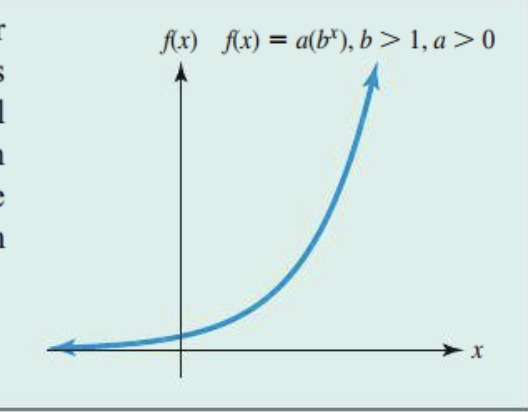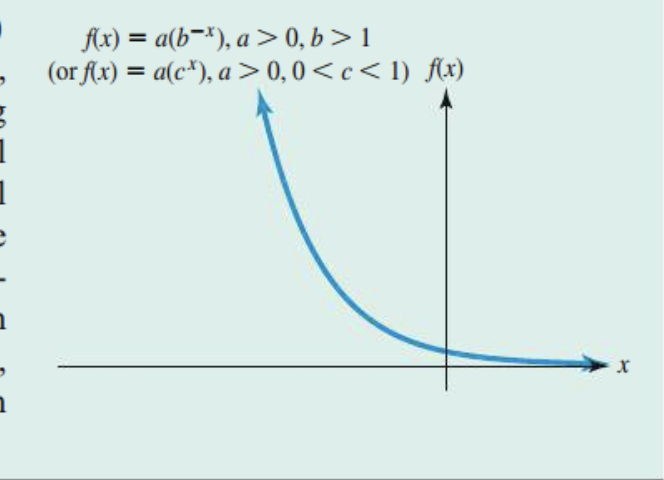5.1, Exponential Functions
1/23
There's no tags or description
Looks like no tags are added yet.
Name | Mastery | Learn | Test | Matching | Spaced |
|---|
No study sessions yet.
24 Terms
This is when a and b are real numbers, B is greater than 0 but doesn’t equal 1. This is expressed as f(x)= a(b^x)
What is an Exponential Function?

This is an Exponential Function where the base, “b” is greater than 1 and a is greater than 0. The growth factor is increasing.
X-intercept: None
Y-intercept: (0,a) whatever a is
Domain (negative infinity, infinity)
Range (0, infinity)
Horizontal Asymptote: X-axis/ Y=0
Shape: Increasing, concaving up
What is an Exponential Growth Function?

This is an Exponential Function where “b” is greater than 1 and “a” is greater than zero; HOWEVER, ‘k’ is LESS than Zero.
X-intercept: None
Y-intercept: (0,a) whatever a is
Domain: (Negative infinity, infinity)
Range (0, infinity)
Horizontal Asymptote: X-axis/ Y=0
Shape: Decreasing, concaving up
What is an Exponential Decay Function?
This formula is continuously compounding. That means a future investment is earning money every moment of every day.
What is S=Pe^rt
This formula is without an “e” is compounding a certain number of times throughout a year. “Compounding annually.”
What is S=P(1+r)^t
Describe what’s happening with the value “k”: g(x) = b^x +k
"k" is positive, meaning a vertical shift upwards of the exponential function.
Describe what’s happening with the value “k”: g(x)=b^x-k
"k" is negative, the graph shifts downward vertically,
Describe what’s happening with the value of “h”: g(x)=b^x-h
“h” is negative, meaning the graph horizontally shifts left
Describe what’s happening with the value of “h”: g(x)=b^x+h
“h” is positive, indicating a horizontal shift to the right.
Describe what’s happening: g(x)= -b^x
The base: “b” is negative, indicating a reflection across the x-axis
Describe what’s happening: g(x)= b^-x
The exponent: “x” is negative, indicating a reflection across the y-axis
Describe what’s happening: g(x)= 2 times b^x
The |a| is greater than 1, meaning the graph is vertically stretched
Describe what’s happening: g(x)= 0.1 times b^x
The |a| is less than 1, meaning the graph is vertically compressed
Describe what’s happening: b²^times x
The |a|= 2, greater than 1, meaning the graph is horizontally compressed
During a 20-year period of constant inflation, the value of a $150,000 property will increase according to the equation v=150,000e^0.04t.
What will the value of the property be in 6 years?
S=Pe^rt → S=150,000e^0.04(6)
= $190,687.37
During a 20-year period of constant inflation, the value of a $150,000 property will increase according to the equation v=150,000e^0.04t.
When will this property be worth double its original value?
$150,000 → $300,000
y1= 150,000e^0.04t
y2= 300,000
Find where they intersect
= Around 17.3 years.